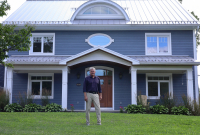Support strong Canadian climate journalism for 2025
Alberta Premier Danielle Smith is using a recent alert urging Albertans to reduce their electricity use as ammunition in her firefight against the federal government’s regulations to clean up Canada’s power grid by 2035.
On Monday afternoon, the Alberta Electric System Operator (AESO) issued the alert due to a combination of hot weather, low wind generation and an outage in B.C. that affected Alberta’s ability to import power from the neighbouring province.
An alert like this means the power grid is under stress and AESO may need to use “emergency reserves to meet demand and maintain system reliability,” so consumers are asked to temporarily reduce their electricity use, according to the operator’s website.
In the days following the alert — which did not result in any rolling blackouts — Smith has repeatedly said the province needs “more natural gas generation brought online asap” to backstop power from wind and solar.
In the case of Monday’s power grid alert, the situation was a lot more complex than Smith made it out to be.
Low wind power was only one of many conditions that led to Alberta’s energy shortfall. Reduced gas generation and outages combined with issues with importing energy from B.C. played a larger role in the shortage.
Forecasts for Monday indicated there would be approximately 120 megawatts (MW) of wind, however, for almost the full duration of the grid alert, there were only about 50 MW available, AESO communications manager Leif Sollid said in an emailed statement to Canada’s National Observer.
“The overall contribution of wind wasn’t significant” when you consider that the peak demand was 11,188 MW, Sollid explained. “We were expecting low wind, and what we got was fairly consistent with expectations.”
There were also four natural gas generators offline or operating at reduced capacity, resulting in a loss of approximately 600 MW during Monday’s grid alert, he said.
During extremely hot weather, the cooling ponds adjacent to natural gas facilities become warmer, and the water circulating through the plants can’t keep them cool enough to operate at optimal temperature, explained Sollid. To compensate, the plants have to operate at a reduced output or capacity.
Adding to the difficulties, one of the lines BC Hydro uses to transfer power to Alberta was out of service for planned maintenance, which reduced its ability to transfer power to Alberta by 466 MW, said Sollid. The line’s return to service and addition of the missing 466 MW was “a significant factor in returning the grid to normal operating conditions,” his statement reads.
Demand was also 100 MW higher than anticipated, Sollid added.
‘It's criminal jail time’
According to Smith, increasing natural gas generation is the answer to Alberta’s energy supply woes.
In Smith’s sustained attack on the federal government’s clean electricity regulations, she regularly claims the incoming regulations will bar provinces from adding more gas generation.
This is false. The federal regulations will allow new gas generation, as long as the facilities use carbon capture technology to curb a majority of the planet-warming greenhouse gas emissions created. Existing gas plants or those opened before the regulations are finalized in 2025 will be able to operate for two decades without any emission-capturing technology, according to federal Environment Minister Steven Guilbeault.
“I wish that carbon capture was as perfect as they think it is,” said Smith when this reality was pointed out to her in a radio interview with Global News this week.
“They say that it has to abate 95 per cent of the emissions by 2035 or you go to jail. Like, let's be clear about what it means. It's criminal jail time.”
“Talking about criminal jail time is deliberately inflammatory,” a spokesperson for Guilbeault’s office said in response to Smith’s comments, pointing out that clean electricity regulations are the same as regulations for phasing out coal. Like the coal regulations, the federal government’s clean energy regulations will fall under the Canadian Environmental Protection Act, which carries criminal liability for failing to meet its requirements.
However, “like many regulations across government, there [is] a spectrum of measures to address non-compliance, that range from written warnings to escalating fines, which get bigger depending on severity,” the spokesperson told Canada’s National Observer in a written statement.
When it comes to stress on the power grid as Alberta’s energy mix changes, there are many ways to plan for and address the issue, said Jason Wang, an Alberta-based senior analyst with the Pembina Institute, a non-profit think tank focused on the energy transition.
Adding more renewable generation to the grid is one piece of the puzzle, he told Canada’s National Observer in a phone interview. Even when there’s low wind, it's still blowing, he pointed out.
“Wind and solar are able to provide energy even throughout the winter,” said Wang. “In our work, we looked back to 2010 and found the worst days of wind availability and solar availability, and looked at: Will we have enough electricity in the system?”
The Pembina Institute’s analysis found the answer was yes across all the scenarios except for the worst-case scenario, where the longest stretch is 12 hours, said Wang. This yet-to-be-released analysis, which Canada’s National Observer reviewed, is based on a 2035 energy mix, evolved from last year’s mix. The model allows for new gas to come online, in accordance with the federal government’s forthcoming clean electricity regulations.
“That's a situation where, you know, simplifying a little bit, if we built like one more (battery) storage facility, we would have been able to cover that gap,” said Wang.
Seven-month renewables moratorium
More generation can help fill this gap, said Wang, pointing to the approximately $33 billion worth of investments in proposed solar and wind projects now stalled because of Alberta’s recently imposed seven-month moratorium on renewable energy project approvals.
“So much more generation wants to come into our market, and having a moratorium doesn't help … with fixing these issues in the shorter term,” said Wang.
That $33 billion is for 118 proposed projects comprising 5.3 gigawatts (GW) of wind, 12.7 GW of solar and 1.5 GW of battery energy storage for solar projects, according to Pembina Institute’s analysis.
Realistically, not all those projects will be built, but it's indicative of developers’ interest in the province’s renewable energy market, he added.
Last year, Alberta led Canada for renewable energy growth, accounting for 77 per cent of the 1.8 GW of solar and wind generation capacity that came online that year, according to data from the Canadian Renewable Energy Association.
Another piece of the puzzle is to reduce electricity demand by making sure our homes are built — or retrofitted — to be more energy efficient, said Wang. More energy-efficient homes use less electricity to stay cool in summer and warm in the winter.
Right now, Alberta only has one provincial intertie with B.C. Expanding the capacity of provinces to share electricity and adding more of these interties will improve grid stability for all, said Wang. However, new transmission lines take time to build, “often in the order of a decade,” he added.
Provinces often have different energy needs in different seasons so interties are a mutually beneficial measure, said Wang. A recent electricity-sharing agreement between Ontario and Québec is the latest example of this.
On Aug. 30, the two provinces announced Ontario’s Independent Electricity System Operator and Hydro-Québec will trade up to 600 MW of energy each year.
The two provinces have complementary seasonal peaks in electricity demand: Ontario’s peak demand occurs in the summer, driven mainly by air conditioning on hot days, and Québec’s peak demand occurs in the winter, driven mainly by electric heating on cold days, according to Ontario’s news release on the agreement. The deal — which could start this winter — will “be a straight swap of capacity with no payments required by either party, protecting ratepayers in both provinces,” according to the release.
The new agreement, lasting up to 10 years, will not require any new transmission lines to be built because there are already six interties between Ontario and Québec transmission systems with a total combined capacity of approximately 2,775 MW.
Natasha Bulowski / Local Journalism Initiative / Canada’s National Observer






Comments
As a former shock-jock Danielle Smith doesn't let the facts interfere with a good headline. Thanks for setting the record straight.
Alberta needs four times the generation capacity mentioned in those projects, and 20X the storage capacity, and three interties with BC.
That's at a dead minimum, to go green. I'm not sure if Mr. Wang's worst-case figures include just last Xmas, when Alberta had a week of -30C, obviously no solar, and, worst, no wind. The province was on 96% gas on Dec. 22, despite 26% capacity for renewables. Solar was at 0%, the whole 17-hour night, and wind was at about 10%.
I think that went on for over 100 hours.
So I guess the Pembina Institute didn't have access to the same information as you somehow?
We need to get of off fossil fuels but journalists and many scientists even have no idea how a grid functions and make the situation worse by demanding "renewables" without storage capabilities. Wind and solar should not be called "renewable" if you can't store the energy to supply when needed. Try going off grid without a battery bank - unless you tie a diesel or gas generator to your "home grid", it cannot be done. Increasing wind and solar without storage only adds to the problem and the gas companies know this. In Ontario, I demonstrated back in 2010 how with renewables getting grid priority, fossil fuel generation would increase. By the summer of 2012 it happened - renewables kicked nuclear generation off of the grid which had to be replaced by fossils. Since then, wind generators are paid NOT to produce energy on days it isn't required. A complete waste. Yes, demand more wind and solar, but also demand storage too.
Wrong. Batteries exist.
Why can Portugal a nation of 5.5 million, just a bit larger than Alberta, run an electric grid with 75% renewables as supply? And good old Alberta Advantage, Alberta Innovates can't.
Portugal has not been captured by the O&G industry who support and fund Manchurian candidates in all our elections in Canada.
As pointed out in the article and by several commenters, adequate power storage is essential for the renewables industry to stand on its own feet, let alone replace fossil fuels.
The battery technology is already there and commercialization of various types is underway to fast ripping success in jurisdictions that fully welcome renewables (e.g. Australia. Scotland. Germany ...).
It may take a decade to build a national smart grid's first energy corridor, but when it's finally in place it would help balance the demand load with supply in milliseconds during shortages. This would occur not just by sending power down the line from other provinces, but by instantaneously tapping the power stored in massive banks of batteries spaced evenly along the entire corridor.
The Smiths of this nation would find it nearly impossible to legally defeat a federal clean energy corridor given the majority support of another boundary-crossing energy corridor demonstrated in the Supreme Court of Canada's decision on TMX that overrode BC's legal challenge based solely on the issue of jurisdiction despite concerns by intervenors about First Nations consultation, municipal permits and threats to land and marine ecosystems.